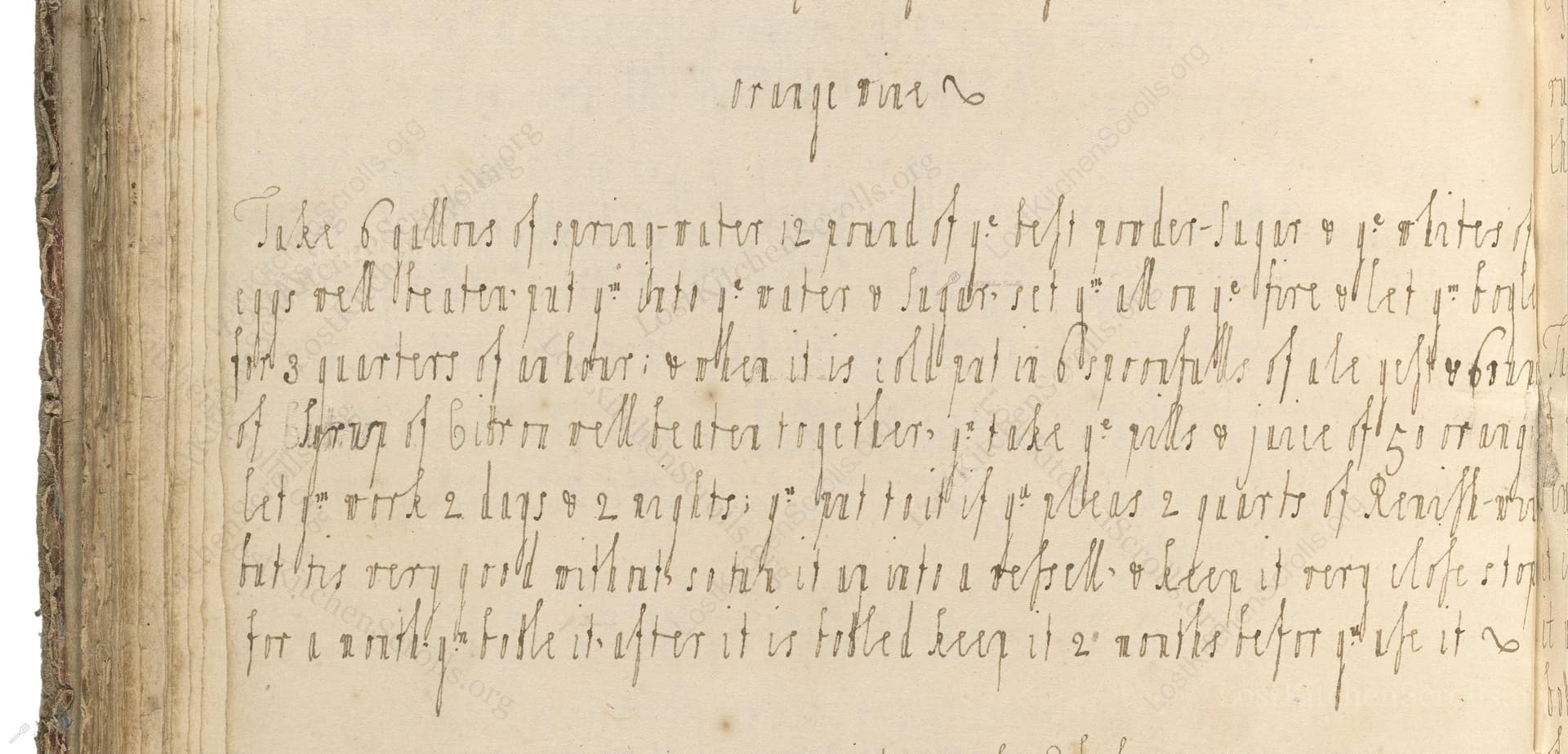Orange Wine
From the treasured pages of Cookbook of Mary Puleston
Written by Mary Puleston

Orange Wine
"Take 6 gallous of spring-water 12 pound of ye best powder-sugar & ye whites of 6 eggs well beaten: put ye into ye water & sugar: set ym all on ye fire & let ym boyle three quarters of an hour: & when it is cold put in 6 spoonfulls of ale yest & 6 ounces of Syirup of Citron well beaten together: ye take ye pills & juice of 50 oranges let ym work 2 days & 2 nights: ye put to it if ye pleas 2 quarts of Renish-wine but tis very good with out: soe tun it up into a vessell & keep it very close stopd for a month: ye botle it: after it is botled keep it 2 months befor ye use it"
Note on the Original Text
This recipe is written in a free-flowing, conversational style common in 18th-century manuscript cookbooks. Spelling is idiosyncratic ('gallous' for gallons, 'ye' for 'the', 'ym' for 'them'), reflecting the non-standardized orthography of the day. Quantities are generous, and the method relies on the cook’s common sense for timing and hygiene. Such instructions capture both the resourcefulness and improvisational spirit of early modern cooks.

Title
Cookbook of Mary Puleston (1764)
You can also click the book image above to peruse the original tome
Writer
Mary Puleston
Era
1764
Publisher
Unknown
Background
A tantalizing compilation of 18th-century culinary wisdom, this collection artfully preserves the flavors, techniques, and charms of British cookery before 1764—inviting modern gourmets to savor a taste of history with every recipe.
Kindly made available by
Folger Shakespeare Library
This orange wine recipe comes from Mary Puleston, who compiled it before her death in 1764. Such recipes were cherished in well-to-do English households before factory-made wines became widespread. Fruit wines were popular throughout the 17th and 18th centuries, offering a seasonal way to preserve the bounty of orchards and spice up the table with fragrant, citrusy flavors. The careful boiling, fermentation, and aging speak to a time when patience—and plenty of oranges—were virtues of hospitality and refinement.

In Mary Puleston's era, cooks used large earthenware or copper cauldrons to boil the water and sugar, with wooden spoons and whisks for mixing. Egg whites were beaten by hand with a whisk or birch twigs. Fermentation took place in wooden barrels or stoneware crocks, covered loosely with cloths to keep out dust but allow air for the yeast. Strainers were cloth or fine hair sieves, and bottling meant corking glass bottles as tightly as possible, sometimes sealing with wax.
Prep Time
1 hr
Cook Time
45 mins
Servings
25
We've done our best to adapt this historical recipe for modern kitchens, but some details may still need refinement. We warmly welcome feedback from fellow cooks and culinary historians — your insights support the entire community!
Ingredients
- 6 gallons spring water
- 12 pounds white powdered sugar
- 6 egg whites (from large eggs)
- 6 tablespoons fresh ale yeast
- 6 ounces citron syrup (or substitute with lemon syrup)
- 50 oranges (juice and zest)
- Optional: 2 quarts Riesling or similar white wine
Instructions
- To make orange wine in the style of the 18th century, begin by placing 6 gallons of spring water and 12 pounds of fine white sugar into a large stainless steel or enamel pot.
- Whisk the whites of 6 large eggs until frothy, then stir them into the sugar-water mixture.
- Heat gently to a boil and simmer for 45 minutes, occasionally skimming off any foam.
- Allow this sweetened water to cool to room temperature.
- Next, beat together 6 tablespoons of fresh ale yeast and 6 ounces of citron syrup (or a homemade mix of lemon or citron juice and sugar), then mix into the cooled liquid.
- Wash 50 oranges well.
- Peel off the zest (only the orange part) and juice all the fruit.
- Add both the zest and juice into the mixture.
- Cover loosely with a cloth and let ferment in a warm place for 48 hours.
- If you wish, add 2 quarts of Riesling or a similar light white wine for added depth.
- Strain and transfer the liquid into a clean, sanitized fermenting vessel, sealing it well.
- Allow to age for one month.
- Bottle the wine in clean, sterilized bottles, cork and store for at least two months before enjoying your homemade orange wine.
Estimated Calories
330 per serving
Cooking Estimates
Preparing the oranges, mixing ingredients, and sanitizing equipment will take about 1 hour. Cooking and simmering the sugar water will take 45 minutes. The recipe yields about 25 servings, and each serving has approximately 330 calories.
As noted above, we have made our best effort to translate and adapt this historical recipe for modern kitchens, taking into account ingredients nowadays, cooking techniques, measurements, and so on. However, historical recipes often contain assumptions that require interpretation.
We'd love for anyone to help improve these adaptations. Community contributions are highly welcome. If you have suggestions, corrections, or cooking tips based on your experience with this recipe, please share them below.
Join the Discussion
Rate This Recipe
Dietary Preference
Main Ingredients

Den Bockfisch In Einer Fleisch Suppen Zu Kochen
This recipe hails from a German manuscript cookbook compiled in 1696, a time whe...

Die Grieß Nudlen Zumachen
This recipe comes from a rather mysterious manuscript cookbook, penned anonymous...

Ein Boudain
This recipe comes from an anonymous German-language manuscript cookbook from 169...

Ein Gesaltzen Citroni
This recipe, dating from 1696, comes from an extensive anonymous German cookbook...
Browse our complete collection of time-honored recipes



